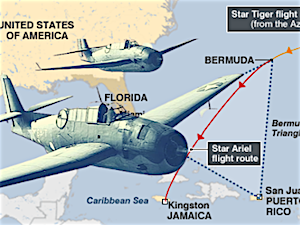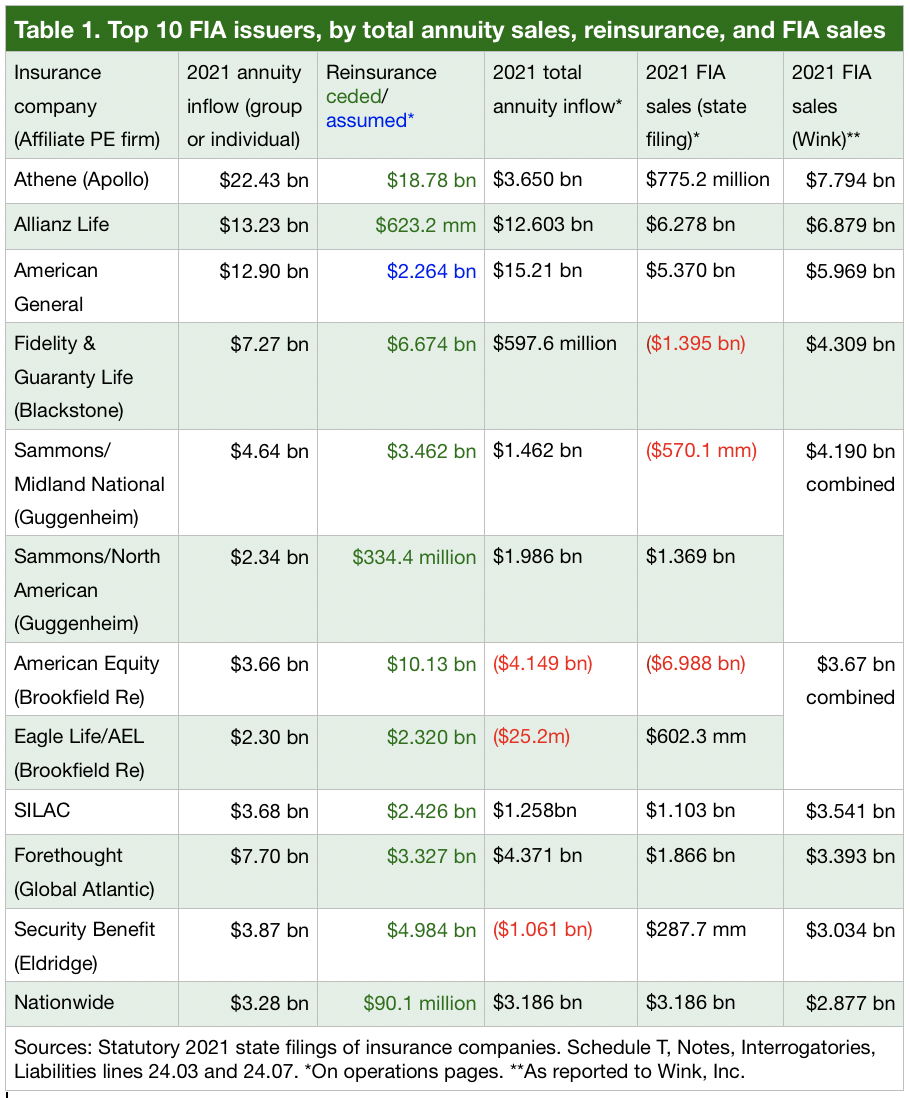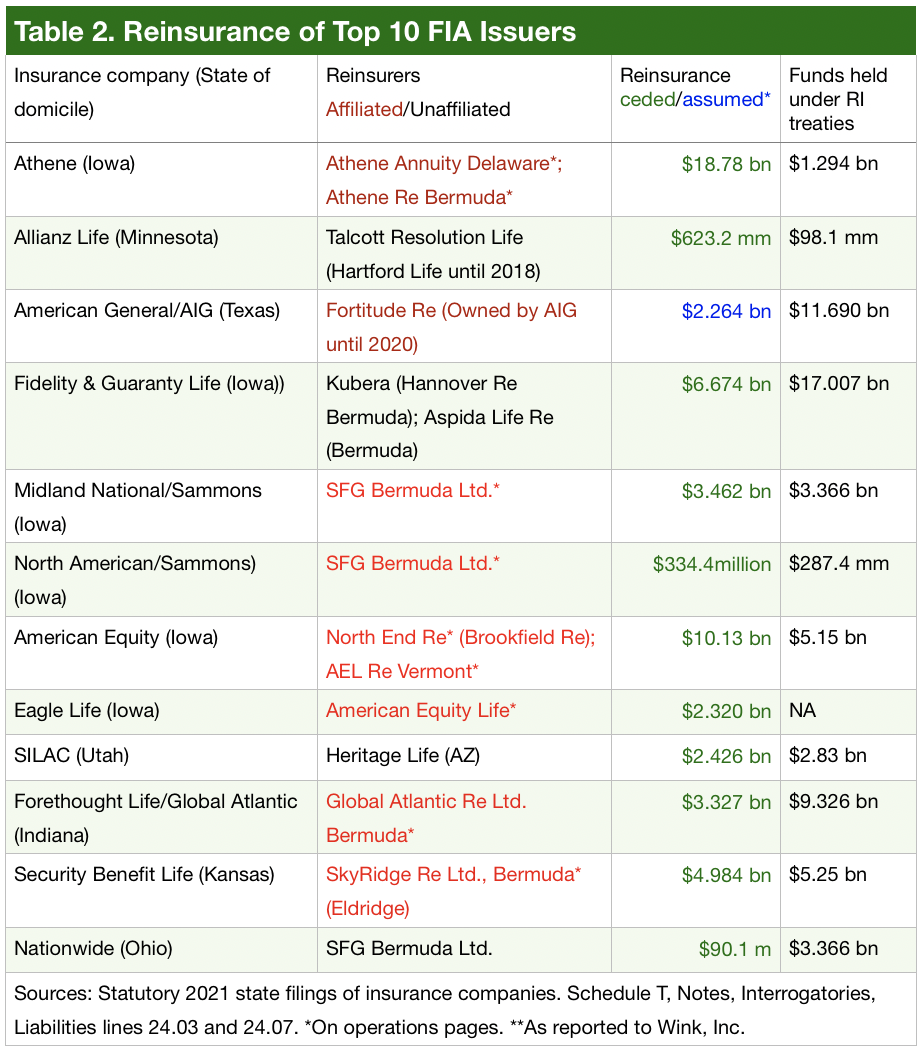
To assess the role of reinsurance in the today’s annuity industry, RIJ recently obtained and analyzed key pages from the most recent state statutory filings of the ten life insurance companies or financial groups that sold the most fixed indexed annuities (FIAs) in 2021.
FIAs, if you’re unfamiliar with them, are structured products inside insurance wrappers. Using options strategies to bet on equity or blended indexes, they’re built to capture part of the gains when equity markets rise over specified periods; they return zero when equity markets fall.
Invented only about 25 years ago, FIAs are now a bread-and-butter product for certain life insurers, with $63 billion in 2021 sales. They flourished after the Great Financial Crisis, thanks in part to their safety. They pose little risk either to the life insurers that issue them or the older investors who typically buy them.
A decade ago, giants in the private equity (PE) and private credit businesses began investing in or partnering with life insurers that issue FIAs. FIAs provide deposits for what RIJ calls the “Bermuda Triangle” strategy, which also involves reinsurance and the creation of private credit.
This week, we look at the 2021 data regarding the reinsurance leg of the triangle. The data comes from the annual statutory filing that life insurers are required to file in the state in which they are legally domiciled.
The numbers here show that leading private equity-linked FIA issuers ceded the risk (the liability) of 95% of their 2021 annuity sales off their own balance sheets and onto the balance sheets of affiliated or co-owned reinsurers located mainly in Bermuda.
At the same time, using a special form of reinsurance, the annuity issuers retained ownership of 61% of the assets backing those liabilities; the affiliated or co-owned Bermuda reinsurers (and their third-party investors) make up the difference. In most cases, the same private equity/private credit firm manages all or a large portion of the assets of both the annuity issuer and the reinsurer. These relationships form the Bermuda Triangle.
Private equity firms dominate FIA sales
The first column of Table 1 shows the largest FIA issuers: The total amount of annuity premium it gathered in 2021, including all types of annuities; the total amount of annuity premium it moved off its balance sheet to a reinsurer; and (in the last three columns) the amounts of annuity premium it reported.
In the first column, the top issuers of FIAs are listed. The results from Sammons Financial Group includes sales of two companies—Midland National and North American. The results from American Equity Investment Life also include two companies—American Equity and Eagle Life. Most of these insurance companies work closely with asset managers, who either started or purchased them, are part owners, or have investment agreements with them.

Asset manager-led life insurers now dominate the FIA industry. Apollo Global Management owns Athene and its reinsurers. Blackstone works closely with Fidelity & Guaranty Life. Eldridge Industries (led by former Guggenheim Partners president Todd Boehly) owns Security Benefit.
Sammons is a significant but minority owner of Guggenheim Partners. Brookfield Re owns 16% of American Equity, according to the Des Moines Register. KKR owns Global Atlantic, which owns Forethought (formerly part of The Hartford). Blackstone has a minority stake in AIG, and will be a part owner of Corebridge, which will be the trade name of AIG’s retirement business after an initial public offering planned for this year.
Only three FIA leaders here without prominent PE ties appear on the top-10 list: Allianz Life (a subsidiary of Allianz of Germany), Nationwide (the household-name multi-line insurer), and SILAC (created in 2015 by former Conseco CEO Steve Hilbert out of Sterling Investors Life).
Reinsurance reduces reported premium
In the next three columns on Table 1, to the right of the company names, note their total annuity sales (of all contract types), the level of “reinsurance ceded” (which is deducted from gross sales on Schedule T of the statutory filings) and the level of total annuity sales net of reinsurance ceded. This is the amount of annuity premium that the issuer “ceded” to its reinsurer(s), another life insurance company or specialized reinsurer. The reinsurance ceded, in effect, changes the amount of premium that reaches the carrier’s balance sheet.
The PE-affiliated companies ceded the most. Athene ceded $18.78 billion of its $22.43 billion in premium; American Equity ceded $10.13 billion; Fidelity & Guaranty Life ceded $6.67 billion; Security Benefit Life ceded $4.98 billion; Midland National (Sammons) ceded $3.46 billion; and Forethought ceded $3.33 billion. American Equity and Fidelity & Guaranty Life ceded so much that they ended up reporting negative premium for the year.
The last two columns in Table 2 show the new FIA premium that each life insurer reported on its statutory filing for 2021 and the 2021 FIA sales it reported to Wink, Inc., which gathers and syndicates annuity sales data and other information. A side-by-side comparison of the two columns shows a correlation between the PE-affiliation, the use of reinsurance, and large differences between the FIA premium reported to the state regulators and to Wink. It’s not clear yet what this correlation might mean.
By contrast, Allianz Life ceded only $600 million and Nationwide ceded only about $90 million. American General itself acted as a reinsurer in 2021, assuming over $2.2 billion in premium from three British insurers. The differences between the FIA premium on their statutory filings and the figures reported to Wink were smaller for these three life insurers than for the other FIA issuers, but the significance of that difference isn’t immediately clear.
Together, the companies in Table 1 reported total annuity sales (group and individual) of $87.3 billion and ceded $52.1 billion, or just over 60%, to reinsurers. The seven PE-linked companies reported total annuity sales of $51.87 billion in 2021 and reported ceding $49.67 billion in 2021. In other words, they ceded the equivalent of 95% their new annuity business to reinsurers.
Affiliated reinsurers
But not to independent reinsurers. The data in the first three columns of Table 2 includes the leading FIA issuers, their home states, their reinsurers (in red, if affiliated), and the amount of annuity business that they reinsured (“reinsurance ceded,” as reported in Table 1). The table shows that PE-linked life insurers ceded their annuity business mainly to affiliated reinsurers.

Athene moved business onto the balance sheet of two affiliated insurers within Athene Holding, whose parent is Apollo. American General, a subsidiary of AIG, ceded business to Fortitude Re, which had been AIG’s own reinsurance division until its sales to a group of investors led by the Carlyle Group in 2020. Fortitude Re is domiciled in Bermuda.
Sammons created SFG Bermuda in 2021 in order to establish its own Bermuda Triangle synergies. American Equity used Brookfield Re, which owns part of American Equity. American Equity affiliate Eagle Life used American Equity as its reinsurer. Forethought and Security Benefit each used its parent’s reinsurer, Global Atlantic and SkyRidge, respectively.
Bermuda-based reinsurers
Most of the reinsurers listed here—Athene Re, Brookfield Re, Fortitude Re, SkyRidge, SFG Bermuda, Kubera, Aspida Life Re, and Global Atlantic—are based in Bermuda. The exceptions are Talcott Resolution Life (which was The Hartford until 2018), and Heritage Life, a Arizona-domiciled life insurer created to serve annuity issuers in need of a specialized type of reinsurance. Bermuda, Arizona, and Vermont are among the jurisdictions where insurers and reinsurers can use different or more flexible accounting standards.
“Modco” reinsurance
A specific type of once-rare type of reinsurance is used in these transactions. “Modco” reinsurance allows FIA issuers to shift liabilities from its own balance sheet to reinsurers while keeping the premium (or assets purchased with the premium) backing the liabilities. These “withheld” funds are still owned by the “ceding company”—the company that sold the annuities in the first place—and are listed as a liability on the ceding company’s balance sheet. (Ownership of the withheld funds may vary from one reinsurance deal to another.)
In more conventional reinsurance negotiations—between unrelated companies—an independent reinsurer wouldn’t accept the risks (investment risk, lapse risk, longevity risk, mortality risk, or interest rate risk, for example) of ceded business without simultaneously receiving enough cash or assets to offset the risks (i.e., to pay the policyholders’ claims and generate a reasonable profit for itself). We’ll describe the purpose of less-than-arm’s-length modco reinsurance between members of the same holding company in a forthcoming article.
What it means, why it matters
None of this would be important if not for two facts about FIAs. They are now the bread-and-butter product for many life insurers. And they have become a sought-after source of funds for private equity and private credit firms like Apollo for lending to high-risk borrowers. Asset managers bundle the loans, slice them into risk-ranked tranches, and sell the tranches to investors who want higher fixed-income yields than public-market bonds with comparable risk profiles offer.
Along with the asset managers and annuity issuers, the Bermuda reinsurers represent the third leg of the Bermuda Triangle strategy—serving as a device for processing US insurance liabilities (annuities, in this case) into high-yield assets for global distribution. Financial firms that control all three corners of the triangle have come to dominate the FIA business.
But why do companies cobble together these legally and financially complex cross-border arrangements? Next week, RIJ will examine the benefits and potential hazards of the reinsurance leg of the Bermuda Triangle.
© 2022 RIJ Publishing LLC. All rights reserved.

